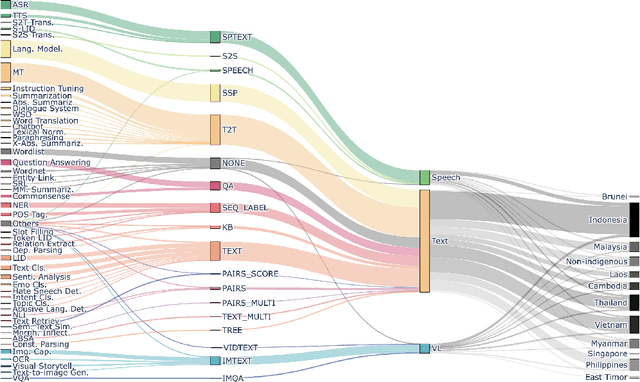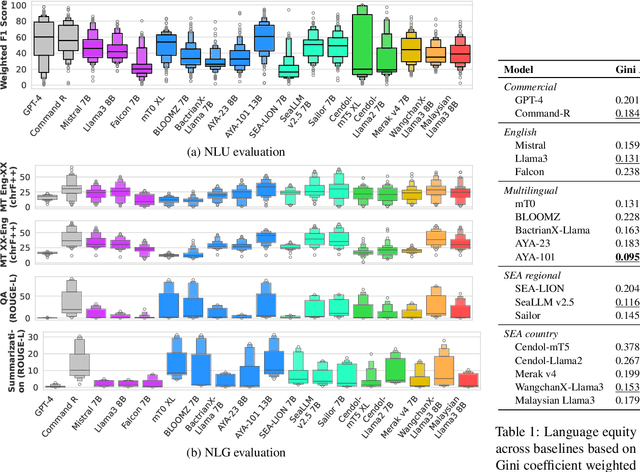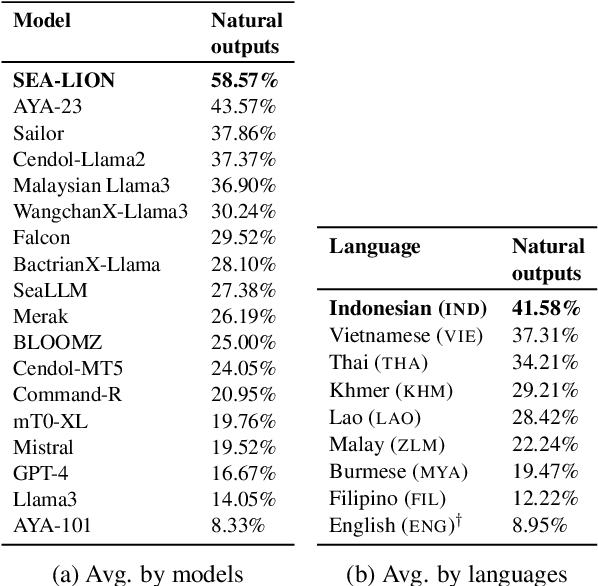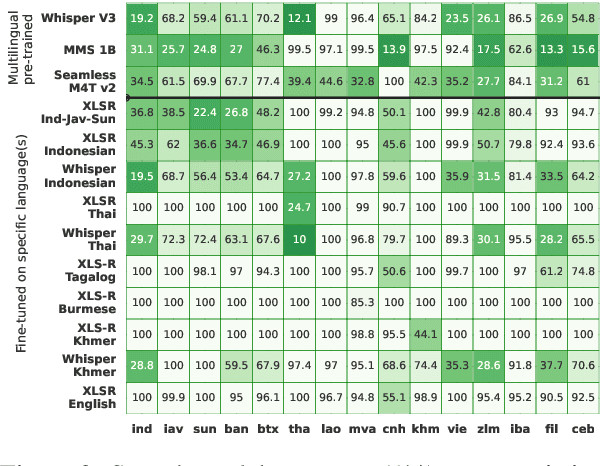Zheng-Xin Yong
Michael Pokorny
Sailor2: Sailing in South-East Asia with Inclusive Multilingual LLMs
Feb 18, 2025Abstract:Sailor2 is a family of cutting-edge multilingual language models for South-East Asian (SEA) languages, available in 1B, 8B, and 20B sizes to suit diverse applications. Building on Qwen2.5, Sailor2 undergoes continuous pre-training on 500B tokens (400B SEA-specific and 100B replay tokens) to support 13 SEA languages while retaining proficiency in Chinese and English. Sailor2-20B model achieves a 50-50 win rate against GPT-4o across SEA languages. We also deliver a comprehensive cookbook on how to develop the multilingual model in an efficient manner, including five key aspects: data curation, pre-training, post-training, model customization and evaluation. We hope that Sailor2 model (Apache 2.0 license) will drive language development in the SEA region, and Sailor2 cookbook will inspire researchers to build more inclusive LLMs for other under-served languages.
Humanity's Last Exam
Jan 24, 2025Abstract:Benchmarks are important tools for tracking the rapid advancements in large language model (LLM) capabilities. However, benchmarks are not keeping pace in difficulty: LLMs now achieve over 90\% accuracy on popular benchmarks like MMLU, limiting informed measurement of state-of-the-art LLM capabilities. In response, we introduce Humanity's Last Exam (HLE), a multi-modal benchmark at the frontier of human knowledge, designed to be the final closed-ended academic benchmark of its kind with broad subject coverage. HLE consists of 3,000 questions across dozens of subjects, including mathematics, humanities, and the natural sciences. HLE is developed globally by subject-matter experts and consists of multiple-choice and short-answer questions suitable for automated grading. Each question has a known solution that is unambiguous and easily verifiable, but cannot be quickly answered via internet retrieval. State-of-the-art LLMs demonstrate low accuracy and calibration on HLE, highlighting a significant gap between current LLM capabilities and the expert human frontier on closed-ended academic questions. To inform research and policymaking upon a clear understanding of model capabilities, we publicly release HLE at https://lastexam.ai.
Towards Understanding the Fragility of Multilingual LLMs against Fine-Tuning Attacks
Oct 23, 2024Abstract:Recent advancements in Large Language Models (LLMs) have sparked widespread concerns about their safety. Recent work demonstrates that safety alignment of LLMs can be easily removed by fine-tuning with a few adversarially chosen instruction-following examples, i.e., fine-tuning attacks. We take a further step to understand fine-tuning attacks in multilingual LLMs. We first discover cross-lingual generalization of fine-tuning attacks: using a few adversarially chosen instruction-following examples in one language, multilingual LLMs can also be easily compromised (e.g., multilingual LLMs fail to refuse harmful prompts in other languages). Motivated by this finding, we hypothesize that safety-related information is language-agnostic and propose a new method termed Safety Information Localization (SIL) to identify the safety-related information in the model parameter space. Through SIL, we validate this hypothesis and find that only changing 20% of weight parameters in fine-tuning attacks can break safety alignment across all languages. Furthermore, we provide evidence to the alternative pathways hypothesis for why freezing safety-related parameters does not prevent fine-tuning attacks, and we demonstrate that our attack vector can still jailbreak LLMs adapted to new languages.
Preference Tuning For Toxicity Mitigation Generalizes Across Languages
Jun 23, 2024



Abstract:Detoxifying multilingual Large Language Models (LLMs) has become crucial due to their increasing global use. In this work, we explore zero-shot cross-lingual generalization of preference tuning in detoxifying LLMs. Unlike previous studies that show limited cross-lingual generalization for other safety tasks, we demonstrate that Direct Preference Optimization (DPO) training with only English data can significantly reduce toxicity in multilingual open-ended generations. For example, the probability of mGPT-1.3B generating toxic continuations drops from 46.8% to 3.9% across 17 different languages after training. Our results also extend to other multilingual LLMs, such as BLOOM, Llama3, and Aya-23. Using mechanistic interpretability tools like causal intervention and activation analysis, we identified the dual multilinguality property of MLP layers in LLMs, which explains the cross-lingual generalization of DPO. Finally, we show that bilingual sentence retrieval can predict the cross-lingual transferability of DPO preference tuning.
SEACrowd: A Multilingual Multimodal Data Hub and Benchmark Suite for Southeast Asian Languages
Jun 14, 2024



Abstract:Southeast Asia (SEA) is a region rich in linguistic diversity and cultural variety, with over 1,300 indigenous languages and a population of 671 million people. However, prevailing AI models suffer from a significant lack of representation of texts, images, and audio datasets from SEA, compromising the quality of AI models for SEA languages. Evaluating models for SEA languages is challenging due to the scarcity of high-quality datasets, compounded by the dominance of English training data, raising concerns about potential cultural misrepresentation. To address these challenges, we introduce SEACrowd, a collaborative initiative that consolidates a comprehensive resource hub that fills the resource gap by providing standardized corpora in nearly 1,000 SEA languages across three modalities. Through our SEACrowd benchmarks, we assess the quality of AI models on 36 indigenous languages across 13 tasks, offering valuable insights into the current AI landscape in SEA. Furthermore, we propose strategies to facilitate greater AI advancements, maximizing potential utility and resource equity for the future of AI in SEA.
A Safe Harbor for AI Evaluation and Red Teaming
Mar 07, 2024



Abstract:Independent evaluation and red teaming are critical for identifying the risks posed by generative AI systems. However, the terms of service and enforcement strategies used by prominent AI companies to deter model misuse have disincentives on good faith safety evaluations. This causes some researchers to fear that conducting such research or releasing their findings will result in account suspensions or legal reprisal. Although some companies offer researcher access programs, they are an inadequate substitute for independent research access, as they have limited community representation, receive inadequate funding, and lack independence from corporate incentives. We propose that major AI developers commit to providing a legal and technical safe harbor, indemnifying public interest safety research and protecting it from the threat of account suspensions or legal reprisal. These proposals emerged from our collective experience conducting safety, privacy, and trustworthiness research on generative AI systems, where norms and incentives could be better aligned with public interests, without exacerbating model misuse. We believe these commitments are a necessary step towards more inclusive and unimpeded community efforts to tackle the risks of generative AI.
LexC-Gen: Generating Data for Extremely Low-Resource Languages with Large Language Models and Bilingual Lexicons
Feb 21, 2024Abstract:Data scarcity in low-resource languages can be addressed with word-to-word translations from labeled task data in high-resource languages using bilingual lexicons. However, bilingual lexicons often have limited lexical overlap with task data, which results in poor translation coverage and lexicon utilization. We propose lexicon-conditioned data generation (LexC-Gen), a method that generates low-resource-language classification task data at scale. Specifically, LexC-Gen first uses high-resource-language words from bilingual lexicons to generate lexicon-compatible task data, and then it translates them into low-resource languages with bilingual lexicons via word translation. Across 17 extremely low-resource languages, LexC-Gen generated data is competitive with expert-translated gold data, and yields on average 5.6 and 8.9 points improvement over existing lexicon-based word translation methods on sentiment analysis and topic classification tasks respectively. We show that conditioning on bilingual lexicons is the key component of LexC-Gen. LexC-Gen is also practical -- it only needs a single GPU to generate data at scale. It works well with open-access LLMs, and its cost is one-fifth of the cost of GPT4-based multilingual data generation.
Aya Model: An Instruction Finetuned Open-Access Multilingual Language Model
Feb 12, 2024



Abstract:Recent breakthroughs in large language models (LLMs) have centered around a handful of data-rich languages. What does it take to broaden access to breakthroughs beyond first-class citizen languages? Our work introduces Aya, a massively multilingual generative language model that follows instructions in 101 languages of which over 50% are considered as lower-resourced. Aya outperforms mT0 and BLOOMZ on the majority of tasks while covering double the number of languages. We introduce extensive new evaluation suites that broaden the state-of-art for multilingual eval across 99 languages -- including discriminative and generative tasks, human evaluation, and simulated win rates that cover both held-out tasks and in-distribution performance. Furthermore, we conduct detailed investigations on the optimal finetuning mixture composition, data pruning, as well as the toxicity, bias, and safety of our models. We open-source our instruction datasets and our model at https://hf.co/CohereForAI/aya-101
Representativeness as a Forgotten Lesson for Multilingual and Code-switched Data Collection and Preparation
Oct 31, 2023Abstract:Multilingualism is widespread around the world and code-switching (CSW) is a common practice among different language pairs/tuples across locations and regions. However, there is still not much progress in building successful CSW systems, despite the recent advances in Massive Multilingual Language Models (MMLMs). We investigate the reasons behind this setback through a critical study about the existing CSW data sets (68) across language pairs in terms of the collection and preparation (e.g. transcription and annotation) stages. This in-depth analysis reveals that \textbf{a)} most CSW data involves English ignoring other language pairs/tuples \textbf{b)} there are flaws in terms of representativeness in data collection and preparation stages due to ignoring the location based, socio-demographic and register variation in CSW. In addition, lack of clarity on the data selection and filtering stages shadow the representativeness of CSW data sets. We conclude by providing a short check-list to improve the representativeness for forthcoming studies involving CSW data collection and preparation.
Low-Resource Languages Jailbreak GPT-4
Oct 03, 2023


Abstract:AI safety training and red-teaming of large language models (LLMs) are measures to mitigate the generation of unsafe content. Our work exposes the inherent cross-lingual vulnerability of these safety mechanisms, resulting from the linguistic inequality of safety training data, by successfully circumventing GPT-4's safeguard through translating unsafe English inputs into low-resource languages. On the AdvBenchmark, GPT-4 engages with the unsafe translated inputs and provides actionable items that can get the users towards their harmful goals 79% of the time, which is on par with or even surpassing state-of-the-art jailbreaking attacks. Other high-/mid-resource languages have significantly lower attack success rate, which suggests that the cross-lingual vulnerability mainly applies to low-resource languages. Previously, limited training on low-resource languages primarily affects speakers of those languages, causing technological disparities. However, our work highlights a crucial shift: this deficiency now poses a risk to all LLMs users. Publicly available translation APIs enable anyone to exploit LLMs' safety vulnerabilities. Therefore, our work calls for a more holistic red-teaming efforts to develop robust multilingual safeguards with wide language coverage.
 Add to Chrome
Add to Chrome Add to Firefox
Add to Firefox Add to Edge
Add to Edge